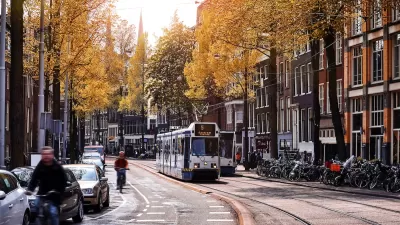There are various ways to define transport efficiency which can lead to very different conclusions as to what transport policies and projects are best overall. Conventional planning tends to evaluate transport system performance based on mobility, which assumes that faster travel is always better. A new planning paradigm evaluates transport system performance based on accessibility (people's ability to access services and activities) which leads to very different definitions of efficiency and very different conclusions about how to improve transport systems.
Planners are professional do-gooders. Our job is to improve the world by helping decision-makers choose optimal solutions. Specifically, we develop analysis frameworks that define problems and goals, and evaluate potential improvements. This process translates general, qualitative concepts into specific, quantitative analysis suitable for decision-making.
Qualitative analysis defines what is considered good or bad. Quantitative analysis measures their magnitude –how good or bad – which is important when decisions involve trade-offs between different goals. For example, qualitative analysis may indicate that economic development, safety and pollution reduction are desirable goals, but quantitative analysis is needed to determine whether a specific economic development strategy is justified if it reduces safety or increases pollution.
Quantitative analysis often defines goals in terms of efficiency, which refers to the ratio of inputs (costs) to outputs (benefits). Economic efficiency and cost effectivness are measured using monetized (measured in monetary units) indicators such as benefit/cost ratios, net present value or return on investment: higher values indicate greater efficiency. Such values are easy to understand and so can dominate decision-making. For example, if an analyst presents a graph indicating that one policy or project has a much higher benefit/cost ratio than others, that option will usually be selected.
Of course, the devil is in the details. Some impacts are easier to monetize than others, and so tend to receive greater weight in economic evaluation. This is particularly important for transport planning, which tends to have diverse impacts.
There are several possible ways to measure transport system efficiency, which can result in very different conclusions about what solutions are optimal:
- Conventional roadway planning evaluates roadway efficiency based primarily on motor vehicle travel speeds. From this perspective increasing transport system efficiency requires increasing roadway capacity and design speeds. This supports roadway expansions.
- Traffic network planning evaluates roadway efficiency based on automobile access, and so recognizes the reduced travel distances that result from more connected road networks and two-way streets. This supports efforts to increase both traffic speeds and road network connectivity.
- Multi-modal transport planning recognizes that travel demands are diverse because not everybody can drive, and transport costs (including road space, parking, vehicle, travel time, accident risk and environmental costs) and benefits vary. For example, it is inefficient if inadequate transport options forces parents to chauffeur children to school if they would prefer to walk or bicycle, or forces commuters to drive when public transit is overall cheaper. From this perspective transport systems are most efficient if they support and encourage use of resource-efficient modes, so users choose the most efficient option for each trip. This supports complete streets policies, including bike- and bus-lanes, and other efforts to improve and encourage use of resource efficient modes.
- Accessibility-based transport planning recognizes that mobility is seldom an end in itself; the ultimate goal of most transport is access [PDF] to services and activities such as education, employment, shopping and recreation. Several factors can affect accessibility including mobility (travel speed and affordability), the quality of transport options, transport network connectivity, land use accessibility, and mobility substitutes such as telecommunications and delivery services. From this perspective, transport systems are most efficient if they increase road network connectivity, support efficient modes, and encourage more accessible land use. This justifies integrated planning that increases transport network connectivity and supports more accessible and multi-modal community development.
- Economic efficiency refers to the degree that consumer benefits provided by a good exceeds the costs of producing that good (roads can be considered a good consumed by users). From this perspective roads are most efficient if managed or priced to favor higher-value trips and more resource-efficient modes over lower-value trips and less efficient modes. This can justify priority treatment of freight and service vehicles (they tend to be high value), and public transit and high occupant vehicles (they tend to be space efficient), or even better, congestion pricing (road tolls that are higher during peak periods) that test users’ willingness to pay for scarce road space, which allows higher value trips and more efficient modes to outbid lower-value trips and more space-intensive modes.
- Planning efficiency refers to the degree that planning activities are comprehensive and integrated, so that individual, short-term decisions support strategic, long-term goals. This is functional way to develop more accessible and economically efficient roadway systems. From this perspective transport systems are most efficient if planned, designed and managed to support strategic objectives. For example, efficient planning justifies special truck lanes if that supports regional industries, bus lanes and pedestrian improvements that support transit oriented development, streetscaping that supports local commercial district redevelopment, and constraints on urban fringe roadway expansion if that support strategic objectives to encourage more compact development.
A recent study published in the Journal of the American Planning Association highlights this issue. "Does Accessibility Require Density or Speed?" [PDF] analyzed of the number of destinations that can be reached within a given travel time by automobile and transit for about 30 US metropolitan areas. The results indicate that increased proximity from more compact and centralized development has about ten times more influential on overall accessibility than the same percentage increase in vehicle traffic speeds. This illustrates how different evaluation methods can result in very different conclusions about what solutions are best overall.
It is important that anybody involved in planning understand the omissions and biases of their analysis methods. When somebody claims that a particular option is efficient it is important to investigate exactly how efficiency is defined and measured. An option that seems good when evaluated in one way often turns out to be bad when evaluated using a more comprehensive and objective evaluation framework.
For More Information
Steve Abley, Paul Durdin and Malcolm Douglass (2010), Integrated Transport Assessment Guidelines, Report 422, Land Transport New Zealand (www.nzta.govt.nz); at www.nzta.govt.nz/resources/research/reports/422.
Richard Dowling, et al. (2008), Multimodal Level Of Service Analysis For Urban Streets, NCHRP Report 616, Transportation Research Board (www.trb.org); at http://trb.org/news/blurb_detail.asp?id=9470; User Guide at http://onlinepubs.trb.org/onlinepubs/nchrp/nchrp_w128.pdf.
Eric Dumbaugh (2012), Rethinking the Economics of Traffic Congestion, Atlantic Cities (www.theatlanticcities.com), 1 June 2012; at www.theatlanticcities.com/commute/2012/06/defense-congestion/2118.
GIZ (2011), Changing Course in Urban Transport- An Illustrated Guide, Sustainable Urban Transport Project (www.sutp.org) Asia and GIZ; at www.sutp.org/index.php?option=com_content&task=view&id=2825.
Jonathan Levine, Joe Grengs, Qingyun Shen and Qing Shen (2012), “Does Accessibility Require Density or Speed?” Journal of the American Planning Association, Vol. 78, No. 2, pp. 157-172, http://dx.doi.org/10.1080/01944363.2012.677119; at www.connectnorwalk.com/wp-content/uploads/JAPA-article-mobility-vs-proximity.pdf. Also see, Metropolitan Accessibility: Comparative Indicators for Policy Reform, at www.umich.edu/~umaccess/index.html.
Todd Litman (2001), What’s It Worth? Life Cycle and Benefit/Cost Analysis for Evaluating Economic Value, Presented at Internet Symposium on Benefit-Cost Analysis, Transportation Association of Canada (www.tac-atc.ca); at www.vtpi.org/worth.pdf.
Todd Litman (2011), Smart Congestion Relief: Comprehensive Analysis Of Traffic Congestion Costs and Congestion Reduction Benefits, Victoria Transport Policy Institute (www.vtpi.org); at www.vtpi.org/cong_relief.pdf
Todd Litman (2012), Toward More Comprehensive and Multi-modal Transport Evaluation, VTPI (www.vtpi.org); at www.vtpi.org/comp_evaluation.pdf.
John Poorman (2005), “A Holistic Transportation Planning Framework For Management And Operations,” ITE Journal, Vol. 75, No. 5 (www.ite.org), May, pp. 28-32; at www.ite.org/membersonly/itejournal/pdf/2005/JB05EA28.pdf.
UITP (2012), Better Urban Mobility in Developing Countries: Problems, Solutions and Good Practices, International Association of Public Transport (www.uitp.org); at www.uitp.org/publications/brochures/Dev-Countries-uk.pdf.

Planetizen Federal Action Tracker
A weekly monitor of how Trump’s orders and actions are impacting planners and planning in America.

Map: Where Senate Republicans Want to Sell Your Public Lands
For public land advocates, the Senate Republicans’ proposal to sell millions of acres of public land in the West is “the biggest fight of their careers.”

Restaurant Patios Were a Pandemic Win — Why Were They so Hard to Keep?
Social distancing requirements and changes in travel patterns prompted cities to pilot new uses for street and sidewalk space. Then it got complicated.

Platform Pilsner: Vancouver Transit Agency Releases... a Beer?
TransLink will receive a portion of every sale of the four-pack.

Toronto Weighs Cheaper Transit, Parking Hikes for Major Events
Special event rates would take effect during large festivals, sports games and concerts to ‘discourage driving, manage congestion and free up space for transit.”

Berlin to Consider Car-Free Zone Larger Than Manhattan
The area bound by the 22-mile Ringbahn would still allow 12 uses of a private automobile per year per person, and several other exemptions.
Urban Design for Planners 1: Software Tools
This six-course series explores essential urban design concepts using open source software and equips planners with the tools they need to participate fully in the urban design process.
Planning for Universal Design
Learn the tools for implementing Universal Design in planning regulations.
Heyer Gruel & Associates PA
JM Goldson LLC
Custer County Colorado
City of Camden Redevelopment Agency
City of Astoria
Transportation Research & Education Center (TREC) at Portland State University
Camden Redevelopment Agency
City of Claremont
Municipality of Princeton (NJ)





























